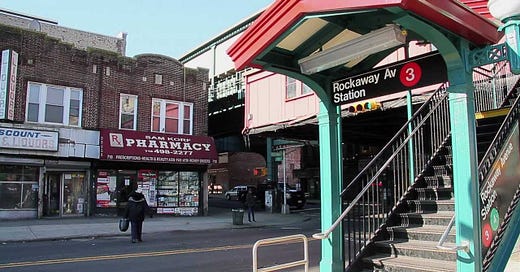What Men In Brownsville Told Me
Notes From A Poor Black Nabe That Moved 20 Points To Trump From 2016 and 2024
Back in May, I found myself, through my regular day job, working on the streets of Brownsville.
The neighborhood in East Brooklyn is often derided as a “slum.” Beset with poverty and lacking the necessary investments from the local and federal government, it has developed a reputation for being a crime-ridden community that New York natives like myself were regularly warned to avoid.
I don’t feel as unsafe in neighborhoods like Brownsville as I used to. I grew up just across the border in Queens. For a while, I lived part-time with my ex in the South Bronx; when I was a reporter, I regularly covered stories in neighborhoods like South Jamaica, Queens. I’ve been mugged three times – twice in “low crime” areas1 – so I’ve developed “street smarts” growing up in the big city. Plus, the negative stereotype that Brownsville is a place you won’t escape alive is way overwrought. The crime rate in Brownsville today is lower than it was in Midtown in the late 1980s.
I decided to take the opportunity to work in Brownsville when it was offered to me. During the three weeks I worked there, I met over three dozen people who were on some form of housing assistance – a common occurrence in a place as impoverished as Brownsville. More than half of them were single men.
Most of the men who met with me felt comfortable sharing and opening up to me. They were almost all born into poverty in the area, and nearly all of them worked, mainly in gig work. I met a special education teacher, a student at a trade school, a delivery person, and a home health aide – all of whom were unable to earn enough money to afford a home and needed government assistance for housing from programs like CityFHEPS. Some were also enrolled in other programs, such as SSDI or food stamps, due to disabilities.
I felt comfortable letting them open up to me about their political views. Only two of them voted – both for Donald Trump – and seven others told me they voted for Barack Obama, Hillary Clinton, or Joe Biden in the past, including the two Trump voters. It shouldn’t have come as a surprise, as Brownsville is one of the many lower-income, minority-majority neighborhoods in New York City that swung heavily to Trump last year.
Brownsville’s shift to Trump wasn’t as remarkable as other neighborhoods, like Corona, Queens, which moved more than 50 points toward him since 2016. Still, it’s notable because this was one of the most Democratic and historically left-wing parts of the country. Back in the early 20th Century, when Brownsville was mainly a poor Jewish community, the neighborhood elected one of the first socialists in the country to office – Abraham I. Shiplacoff – who was later prosecuted for violations of the Espionage Act.
The men I spoke to, all men of color, are part of an alienated political base that progressives believe their agenda and worldview would win. They weren’t the only men I talked to, but the only ones who later agreed to be part of an article. I met five more men, all of whom echoed Republican talking points about crime, immigration, and social welfare, who were not open to being quoted here. In total, about 15 men, all black, Latino, or of mixed race, spoke to me about their political culture and what drew them to Trump or, in some cases, to no one at all. It was an enlightening experience.
Keep reading with a 7-day free trial
Subscribe to Nick Rafter Writes to keep reading this post and get 7 days of free access to the full post archives.





